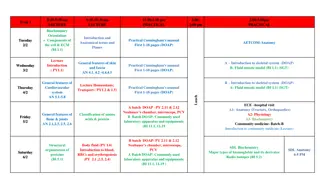Understanding Extracellular Matrix (ECM) and Its Functions
Extracellular Matrix (ECM) is a complex network of proteins, glycoproteins, and macromolecules that provide structural support, regulate cell activities, and play crucial roles in various tissues. It consists of two main types - interstitial matrix and basement membrane, each serving specific functions in different tissues. ECM functions include structural support for cells, regulation of cell division and motility, reserve of growth factors, signal transduction, and more. It is essential for maintaining tissue integrity, providing hardness to bones and teeth, and conveying information to adjacent cells. All multicellular animals have ECM to support cell organization, tissue compartmentalization, and cell migration during development, tissue maintenance, and healing processes.
Download Presentation

Please find below an Image/Link to download the presentation.
The content on the website is provided AS IS for your information and personal use only. It may not be sold, licensed, or shared on other websites without obtaining consent from the author. Download presentation by click this link. If you encounter any issues during the download, it is possible that the publisher has removed the file from their server.
E N D
Presentation Transcript
MATRICE EXTRACELLULARE - ECM Le componenti della ECM sono organizzate in un unica ultrastruttura E un complesso miscuglio di 300 + i) Proteine - tri-dimensionale ii) Glicoproteine - tessuto-specifica. proteoglicani iii) - variazioni della quantit relativa dei vari tipi di macromolecole Diversit di forme e funzioni, adatte ai requisiti di ciascun tessuto - modo in cui esse si organizzano
Distinguiamo due tipi di ECM La matrice extracellulare (interstiziale) dei tessuti connettivi La lamina basale Nella matrice interstiziale le molecole tendono a formare un lattice tridimensionale, la membrana basale si organizza in un piano Nelle lamine basali le molecole di ECM sono deposte solo sulla superficie basale su cui sono si adagiano le cellule Nella matrice extracellulare le molecole dell ECM circondano le cellule riempiendo gli spazi interstiziali intercellulari
Types of ECMs Basement membrane (basal lamina) Epithelia, endothelia, muscle, fat, nerves Stromal or interstitial matrix Elastic fibers Skin, lung, large blood vessels Bone, tooth, and cartilage Tendon and ligament
Funzioni dell ECM (attive) Ruolo strutturale: supporto per le cellule Sviluppo migrazione differenziamento Regolazione divisione cellulare adesione motilit Riserva di fattori di crescita Trasduzione del segnale molecole dell ECM -> recettori di superficie -> espressione genica
Why do all multicellular animals have ECM? Act as structural support to maintain cell organization and integrity (epithelial tubes; mucosal lining of gut; skeletal muscle fiber integrity) Compartmentalize tissues (pancreas: islets vs. exocrine component; skin: epidermis vs. dermis) Provide hardness to bone and teeth (collagen fibrils become mineralized) Present information to adjacent cells: Inherent signals (e.g., RGD motif in fibronectin) Bound signals (BMP7, TGF , FGF, SHH) Serve as a highway for cell migration during development (neural crest migration), in normal tissue maintenance (intestinal mucosa), and in injury or disease (wound healing; cancer)
Nella maggior parte dei tessuti connettivi le macromolecole della matrice sono secrete in gran parte dai fibroblasti Altre proteine della famiglia dei fibroblasti: Condroblasti -> formano la cartilagine Osteoblasti -> formano l osso
Types of ECM Components Hyaluronan (no protein core) Proteoglycans Perlecan, aggrecan, agrin, collagen XVIII Collagens Fibrillins, elastin, LTBPs, MAGPs, fibulins Large Glycoproteins Laminins, nidogens, fibronectin, vitronectin Matricellular Proteins SPARC, Thrombospondins, Osteopontin, tenascins
GLYCOS AMINO GLYCANs - GAGs Glycosaminoglycans (GAGs) are - unbranched polysaccharide chains - composed of repeating disaccharide units. One of the two sugars in the repeating disaccharide is always an amino sugar (N-acetylglucosamine or N-acetylgalactosamine), which in most cases is sulfated (----). The second sugar is usually a uronic acid (glucuronic or iduronic).
Hyaluronan (also called hyaluronic acid (HA) or hyaluronate) Is the simplest of the GAGs. It consists of a regular repeating sequence of up to 25,000 disaccharide units, is found in variable amounts in all tissues and fluids in adult
HA is synthesized at the plasma membrane by a group of highly specialized membrane proteins: HA synthases (HASs) Hyaluronan synthases (HAS1, HA2, HAS3) are integral plasma membrane proteins that utilize UDP-glucuronic acid and UDP-N-acetyl glucosamine substrates to alternately add monosaccharide units to a growing chain of hyaluronan. Synthesis and turnover of HA. The HA synthases (HAS) 1 3 produce HA in the plasma membrane of different sizes and at different rates. The hyaluronidases (Hyal) hydrolyze HA.
Hyaluronan (also called hyaluronic acid (HA) or hyaluronate) Functions: - Controls tissue hydration by retaining large quantities of water. - Protects and lubricates soft tissues (a consequence of its viscoelastic properties) - Aids in the repair process by mediating cell adhesion, differentiation, motility and proliferation. - Transports nutrients to and from cells.
FDA approved HA for cosmetic use in humans 2003: The global hyaluronic acid market size is expected to reach USD 9.4 billion in 2022. The global hyaluronic acid market size is expected to reach USD 16.8 billion by 2030, expanding at a CAGR of 7.45%
Role of HA in morphogenesis: Acts as space filler and facilitator of cell migration If synthesized on the basal side of anepithelium, creates a cell-free space into which other cells can migrate The role of HA in atrioventricular canal morphogenesis: In the developing heart, for example, hyaluronan synthesis helps in this way to drive formation of the valves and septa that separate the heart s chambers.
Proteoglycans are composed of GAG chains covalently linked to a core protein Classified by sugar composition - Keratan sulfate - chondroitin sulfate - dermatan sulfate - heparan sulfate Modification of sugar residues allows for enormous diversity Associate with each other and with other ECM components to make complex meshworks
Proteoglycans Are Composed of GAG Chains Covalently Linked to a Core Protein Whereas glycoproteins generally contain relatively short, branched oligosaccharide chains that contribute only a small fraction of their mass, proteoglycans can contain as much as 95% carbohydrate by mass, proteoglycans containmostly unbranched GAG chains, each typically about 80 sugars long
The proteoglycan aggrecan, for example, which is a major component of cartilage, has a mass of about 3 106 daltons with more than 100 GAG chains. Other proteoglycans are much smaller and have only 1 10 GAG chains; an example is decorin, which is secreted by fibroblasts and has a single GAG chain (see Figure 19 31).
Funzione dei proteoglicani Intrappolamento dell acqua Resistenza alla compressione Ritorno alla forma originale Creazione di spazi Legame alle fibre di collagene Formano una rete Nell osso, si combinano con l idrossiapatite di calcio e carbonato di calcio. Adesione cellulare Migrazione cellulare durante lo sviluppo embrionale Possono regolare l attivit di fattori di crescita (quali FGF)
Aggrecan is the major glycoprotein of articular cartilage: Provides hydrated gel structure that endows cartilage with load-bearing properties Chondroskeletal morphogenesis during development
Proteoglycans integral components of plasma membranes Not all proteoglycans are secreted components of the extracellular matrix. Some are integral components of plasma membranes and have their core protein either inserted across the lipid bilayer or attached to the lipid bilayer by a glycosylphosphatidylinositol (GPI) anchor.
Signaling roles of proteoglycans: Proteoglycans can regulate the activities of secreted proteins Gels formed by GAG chains act as sieves that regulate passage of molecules by size and charge Bind secreted signaling molecules Control diffusion, range of action, lifetime, modify signaling activity e.g.,heparan sulfate immobilizes chemokines on the endothelial surface of a blood vessel at a site of inflammation Cell-surface proteoglycans act as co-receptors























